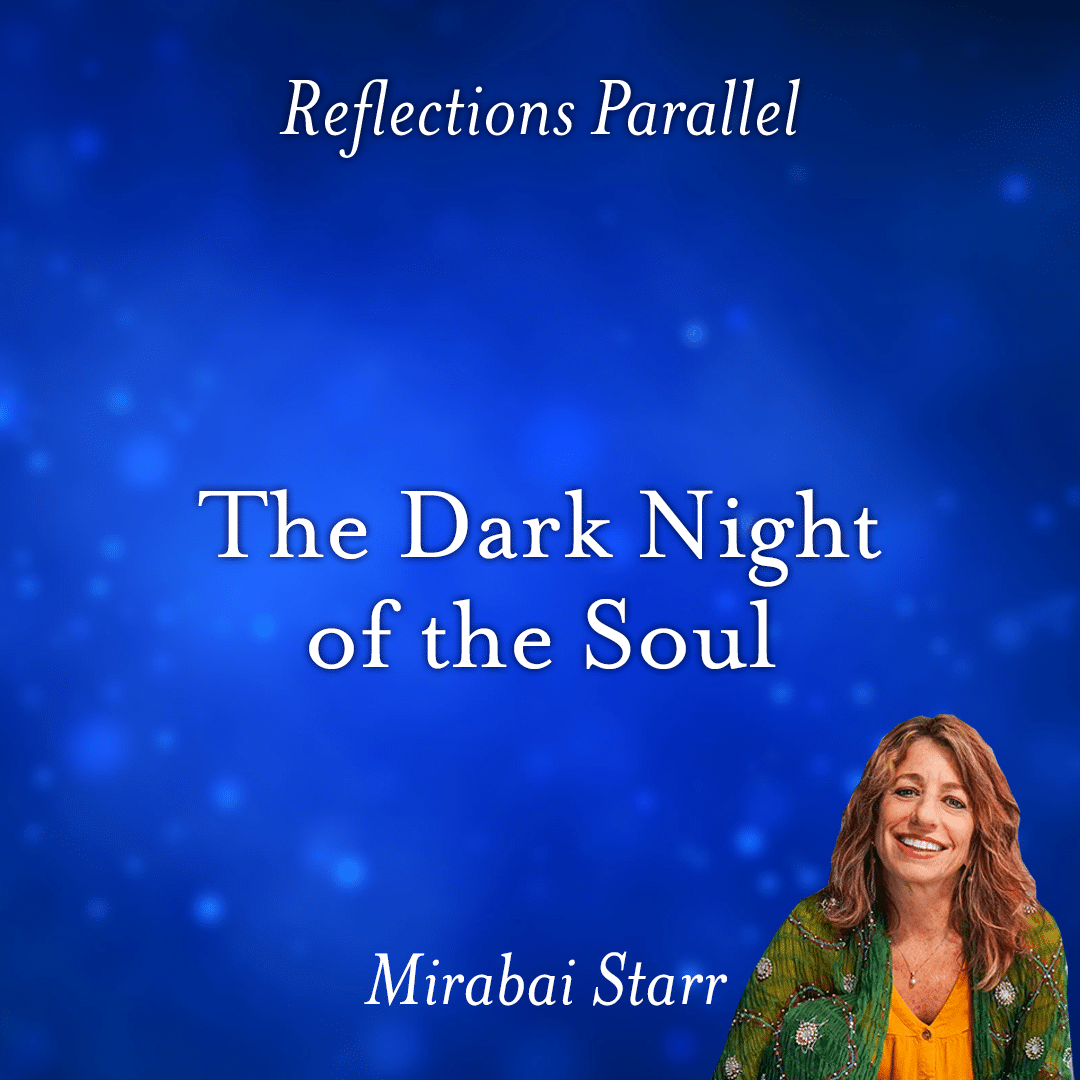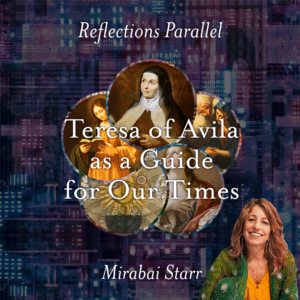Description
Learn more about “The Dark Night of the Soul”
About this Reflections Parallel Series
The Dark Night of the Soul is one of the most comprehensive, radical and paradoxically consoling spiritual teachings of any tradition, given name and form by Saint John of the Cross. We recognize the symptoms of the dark night in our lives because it comes upon us as depression, anxiety, despair and hopelessness. And all too often we stop at the symptoms, looking for obvious reasons for why we are tumbling into darkness – relationships that are ending, loneliness, life challenges that have become overwhelming. But the dark night of the soul is not a condition; it is a journey. It has a profound spiritual purpose – a beginning, a middle and a fruition. Underlying the darkness something utterly profound is unfolding, a transformation of ourselves that could not occur so long as we were locked into beliefs and narratives that subtly disempowered us, though we often do not realize it at the time. In a dark night experience, we are stripped of these storylines and preconceptions and plunged into a naked encounter with a much greater reality of own sacred potential and the power that is love. The dark night is a glorious co-creative dance between our souls and the Divine Beloved, a blend of surrender and stepping up, of personal awakening and collective meaning-making.
The mystics of all traditions offer lucid maps to guide us through wilderness, potent elixirs to transform our consciousness, transmute our hearts, transfigure our bodies, and remake our souls. John of the Cross and his teachings of the dark night are especially vital for navigating, surviving and flourishing in these perilous times in which all our collective illusions are being annihilated before our eyes. We may rightfully call this process a “Dark Night of the World Soul.” If enough of us study, practice and embody such perennial wisdom, we can serve as grounded, generous shepherds for the rest of the human family during this great unraveling and reweaving, and fierce and tender advocates of the creation we share.
Lesson 1:
Session One: Spiritual Crisis
We all undergo periods of personal crucifixion. Like Christ on the cross, we cry out, “O my God, why have you forsaken me?” Like Jonah in the belly of the great fish, we languish in suspended animation, groundless. Like Miriam exiled to the edges of the camp as she accompanied her people on their journey through the desert, we wait for healing, without any certainty that healing will happen. Like Rabia, the slave, we work all day and pray all night, because nighttime is the only time left to be with God. According to mystics of every tradition, these periods of spiritual crisis are portals of initiation. They are signs that we have matured on the path and are ready to cultivate a more direct and intimate encounter with the Holy One.
Takeaways:
- Learn to discern the difference between apathy and groundlessness
- Identify common features of the beginner’s path
- Embrace anxiety & depression as (potentially) sacred states
- Stories of mystics who have undergone spiritual meltdowns
- A practice to meet and welcome your own darkness
Lesson 2:
Session Two: Song of the Soul
When John of the Cross was in his late twenties, he was abducted by mainstream Carmelite brothers and imprisoned in a monastery as punishment for his participation in Teresa of Avila’s reform movement. He spent nine months in a tiny, fetid cell, tortured daily, and became convinced that he had been abandoned by God. Following his miraculous escape, he entered a state of profound ecstasy, out of which flowed one of the most luminous poems in any language, out of which grew his prose masterpiece, Dark Night of the Soul. In this session, we will read the eight-stanza poem and unpack the mystical metaphor of the secret rendezvous of lover and beloved in the garden.
Takeaways:
- Connect to your own wellspring of love-longing
- Identify places where you are contracted and become willing to take the “exquisite risk”
- Embrace desert spirituality
- Forge a relationship with the Holy One as Beloved
- A practice that creates intimacy with the divine
Lessons 3:
Session Three: Night of Sense
John of the Cross distinguishes two phases of the Dark Night of the Soul: Night of Sense and Night of Spirit. In the Night of Sense, we experience a drying up of many of the sources of spiritual juice that had previously motivated us along the path. Prayer, meditation, liturgy, sacred music, all become dry and empty. If we are able to endure these desert spaces without turning away, we may discover “an ineffable sweetness” bubbling up from the dark ground of our own soul.
Takeaways
- Take an inventory of your “spiritual attachments”
- Connect with the spiritual longing underlying your grief
- Become willing to let go of cherished practices, at least for a time
- Notice elements of a collective Night of Sense in the world
- A practice of crying out to God
Lesson 4:
Session Four: Night of Spirit
While the Night of Sense is common to most seekers somewhere along the path of awakening, and involves pain and bewilderment, the Night of Spirit is yet more harrowing and demanding. John calls it the “state of the adept.” This is where cherished conceptual constructs come tumbling down. Our attachments to the ways we had grown accustomed to conceiving of God, ultimate reality and the meaning of life fall away, and we are left in a space of radical not-knowing. This is where we meet the Holy One: in nakedness.
Takeaways:
- Embrace a relationship with the formless
- Become aware of which spiritual concepts support you and which imprison you
- Identify the ways your inner life has changed and matured over the years
- Notice elements of a collective Night of Spirit in the world
- A practice of unknowing
Lesson 5:
Session Five: Ladder of Love
Mystics of all traditions celebrate paradox as the highest truth: luminous darkness, knowing by unknowing, discovering the cure for pain within the pain. John of the Cross reminds us that the way of love is secret and yet he offers us a lucid description of the stations the soul passes through to experience union with the Beloved. He calls this the “ladder of love” and his writing here is among the most ecstatic and also hidden passages of the mystical canon. In this last part of his mystical masterpiece, John shows us that every moment of crucifixion is worth the ever-unfolding beauty of resurrection.
Takeaways:
- Explore your soul’s journey as “secret”
- Explore what it looks like for you to “travel in disguise”
- Ascend the first five steps of the ladder of love
- Drop into the second five stations of love’s ladder
- Celebrate the reunion of lover & Beloved in the Garden
- A practice of conscious deconstruction
Lesson 6:
Session Six: Collective Transfiguration
Many contemporary wisdom teachers are examining our current times as evidence of a global Dark Night. That is, we can view ourselves as passing through a collective initiation, with all the purifying fire that accompanies such a transformational passage. Old ways of relating to the human community and the earth are no longer viable, yet the new path is not yet visible. Toxic structures are crumbling, and we are glad to see them go, but we have no clear picture of what to replace them with. We are in a state of communal unknowing, and we share a sense that this must be the starting place for our shared transfiguration. There is a vibrant creativity and access to a space of profound refuge inherent in this station of the spiritual adventure.
Takeaways:
- Identify features of collective unraveling
- Be willing to serve as an example of “keeping the heart open in hell”
- Discern where you can step up to co-create a new world
- Given that the spiritual crisis of a dark night leads to union with the Beloved, affirm the blessings hidden in the global crises
- Create a plan for a particular (and local) service project

About Mirabai Starr
Mirabai Starr is an award-winning author of creative non-fiction and contemporary translations of sacred literature. She taught Philosophy and World Religions at the University of New Mexico-Taos for 20 years and now teaches and speaks internationally on contemplative practice and inter-spiritual dialog. A certified bereavement counselor, Mirabai helps mourners harness the transformational power of loss.
Her latest book, WILD MERCY: Living the Fierce & Tender Wisdom of the Women Mystics, was named one of the “Best Books of 2019” by Spirituality & Practice. Mirabai is on the 2020 Watkins List of the “100 Most Spiritually Influential Living People of the World.” She lives with her extended family in the mountains of northern New Mexico.







